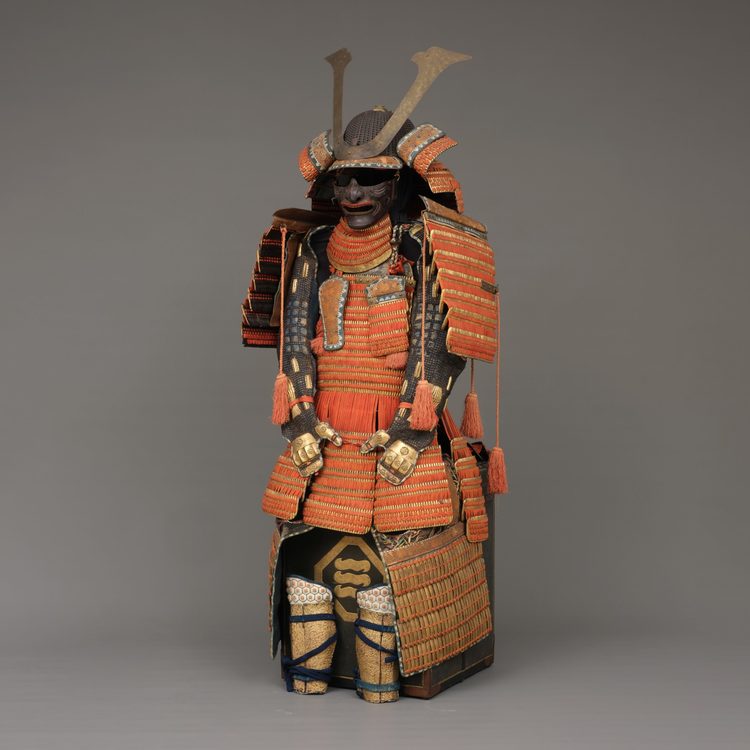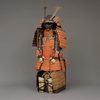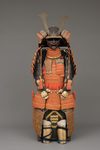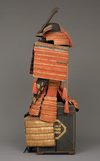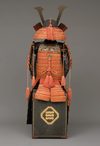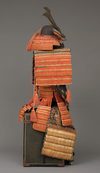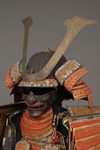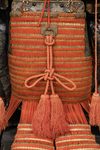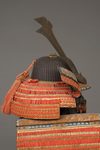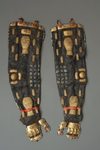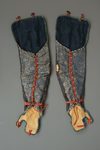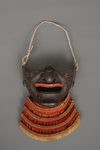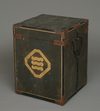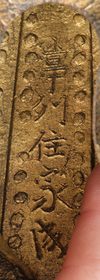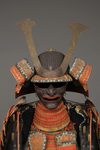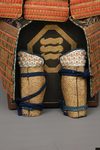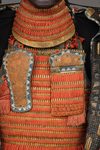Lot 56 GOLD LACQUER JAPANESE SUIT OF ARMOUR (YOROI)
An antique complete ensemble gold lacquer Japanese suit of armour (yoroi) laced with orange silk cords, and a 2-piece cuirass (kin’urushinuri hi’ito nimai’dô tôsei gusoku) featuring a rare sort of haidate.
The set comprises the following key components:
• Ko’boshi kabuto (helmet with small rivets) with a 62-plate ‘russet iron’ bowl meticulously detailed with 62 rows of 25 small pointed rivets, topped by a 6-tiered gilded tehen’no’kanamono (decorative apex fitting) engraved with scrolling foliage. The brass kuwagata-antlers are set in a u-shaped mount adorned with a chrysanthemum motif. The helmet is completed with a 3-tiered gold lacquered ‘kiritsuke kozane’ -plate shikoro (neck guards) and large back-bending fukikaeshi (face guards) featuring decorative ‘smoked leather’ borders. The bowl is signed on the inside.
• ‘Russet iron’ angry man’ facial mask (resseibô-type menpô) with a separate nose piece, featuring gold lacquered teeth. The cheeks include orekugi (cord tying hooks), a large ase nagashi no ana (sweat drain hole), and a 4-tiered yodarekake (throat guard) finished in faux leather texture on the lowest lame.
• Sode (shoulder guards), ô-type, constructed with 6 rows of ‘hon kozane’-plates laced with orange silk cords. The lower corners have heart-shaped openings, and the shoulder guards are adorned with silk cords and tassels.
• Kote (bracer), hisago-type 瓠 (bottle gourd), featuring gold lacquered plates connected by Japanese mail (kaushi-gusari), with some plates shaped like bottle gourds (hence the name). The hand guards (tekko) are decorated with floral emblems in relief over blue-golden silk with a scrolling foliage motif.
• Dô (cuirass), ‘maru dô’-type, constructed with 8 rows of gold lacquered ‘kiritsuke kozane’-plates laced in kebiki odoshi. From the shoulders hang a matching set of a sendannoita (‘satinwood-board’) and a kyûbinoita (dovetail-board). In front a pair of small, and on the back a large cord ring with a orange agemaki (decorative tassel). Hanging from the cuirass 7-parts of 5-piece ‘kiritsuke kozane’-plate kusazuri (tassets).
• Haidate (thigh armour), iyô-type, small lacquered oblong plates laced in 4 rows of 28, bordered with ‘smoked leather’, with above a hand-embroidered lush flower garden along a river. A very rare feature we have never encountered before.
• Suneate (shin guards), tsutsu-type, tube-shaped with large vertical metal plates with a faux-leather textured gold lacquer finish. Connected by hinged and placed over navy silk with golden brocade motif, and with white tateage (knee guards).
Complete with a square store-box for a suit-of armour (yoroi’bako) fitted with ‘pole carrying’-handles and covered with black leather. The front and reverse adorned with a family crest in blind embossing showcasing the ‘Sumikiri kaku ni san no ji’-crest 隅切り角に三の字, showcasing the Kanji symbolizing ‘three’ in a square with cut corners.
This crest has been used by many families, but it is most famously associated with the Ôchi clan 越智氏, the governors of Iyo Province. It was also prominently used by the Kôno clan 河野氏, a warrior family renowned for leading naval forces during the Mongol invasions.
Approx. height with box: 165 cm.
With wooden stand.
Period: Japan – Primarily parts from the Late Edo period (first half 19th century), with the helmet bowl possibly from a later date.
Considering its age, the armour is in very good condition with general traces of wear consistent with its age, such as some lacquer loss and fabric wear. Refurbishing of lacing and inside of the helmet. Please look at the photos for a condition reference.
